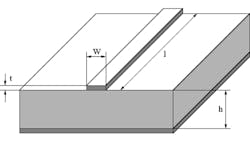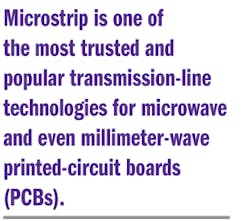Dielectric Microstrip Lines Achieve Low Loss at THz Frequencies
Microstrip is one of the most trusted and popular transmission-line technologies for microwave and even millimeter-wave printed-circuit boards (PCBs). Once frequencies climb above the millimeter-wave frequency range of about 30 to 300 GHz, into the terahertz (THz) frequency range, transmission lines are usually based on metallic waveguide structures.
Several students and researchers from the City University of Hong Kong (Kowloon Tong, Hong Kong) came up with a dielectric microstrip line (DML) integrated circuit (IC) based on silicon semiconductor technology. Electromagnetic (EM) waves are confined to a lower dielectric layer that is bounded by two higher dielectric layers, for low transmission-line loss with high isolation between lines. The effectiveness of the THz transmission-line technology was demonstrated by the design and fabrication of two passive components: a crossover and a coupler.
They demonstrated the transmission-line technology by fabricating passive components operating at frequencies as high as 925 GHz on high-resistivity, silicon-on-insulator (SOI) wafers. Three key material parameters—the height of the conductive strip, the width of the conductive strip, and the height of the dielectric layer—were optimized on the SOI circuits to better understand how to achieve the lowest possible attenuation/loss on DML ICs.
Coupled circuits were also studied on a single DML to better understand the amounts of coupling that existed between two different circuit structures on the same dielectric material. The design details were put to use in the fabrication of a number of passive components, including a crossover and a coupler. Simulations of the crossover showed better than 20-dB isolation and return loss and less than 0.9- dB average insertion loss from 750 to 950 GHz. The coupler was simulated in the same frequency, too, yielding less than 1.42-dB insertion loss from input to output, with better than 24.79-dB isolation and more than 22.88-dB return loss between ports. The coupler consists of two DMLs with a 45-deg. intersection angle on the same plane.
After their computer modeling, the researchers fabricated the components and performed a series of non-contact measurements, also from 750 to 950 GHz. The measurement system was built around waveguide frequency extenders connected to a model N5245A PNA-X vector network analyzer (VNA) system from Agilent Technologies (now Keysight Technologies). Measured results were reasonably close to the simulations from 750 to 925 GHz.
See “Design, Fabrication, and Measurement of the Low-Loss SOI-Based Dielectric Microstrip Line and its Components,” IEEE Transactions on Terahertz Science and Technology, Vol. 6, No. 5, September, 2016, p. 696.
About the Author
Jack Browne
Technical Contributor
Jack Browne, Technical Contributor, has worked in technical publishing for over 30 years. He managed the content and production of three technical journals while at the American Institute of Physics, including Medical Physics and the Journal of Vacuum Science & Technology. He has been a Publisher and Editor for Penton Media, started the firm’s Wireless Symposium & Exhibition trade show in 1993, and currently serves as Technical Contributor for that company's Microwaves & RF magazine. Browne, who holds a BS in Mathematics from City College of New York and BA degrees in English and Philosophy from Fordham University, is a member of the IEEE.


